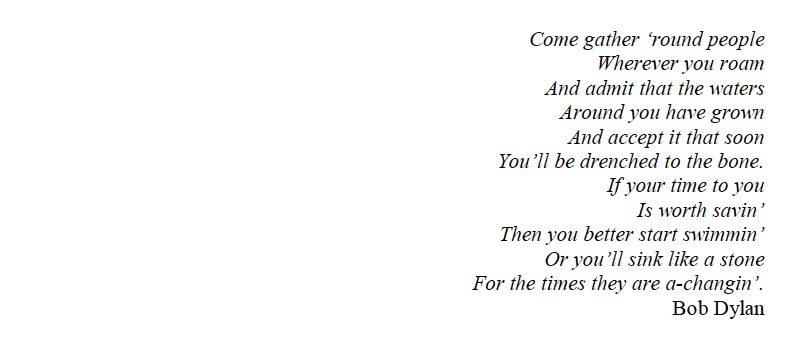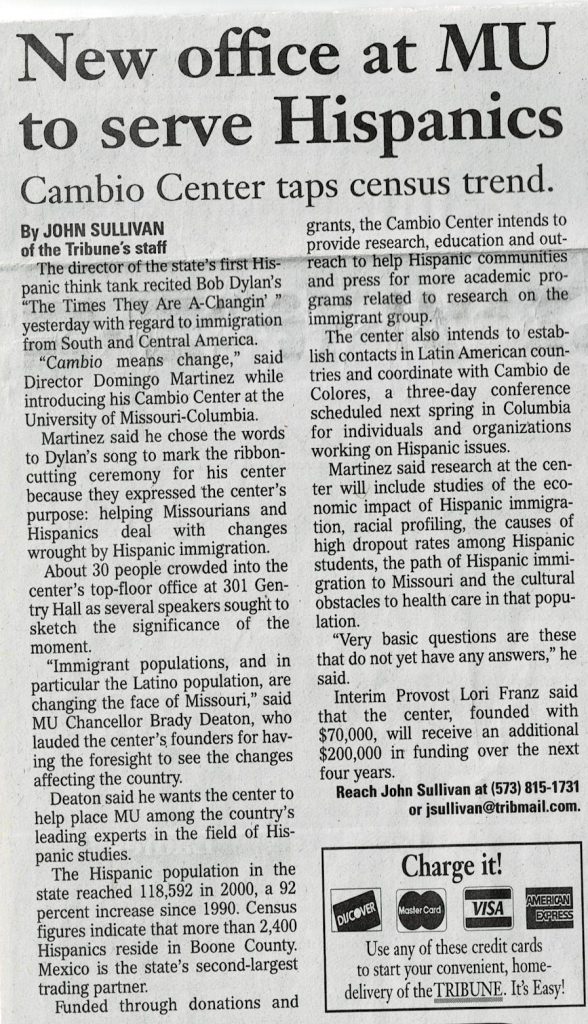Cambio Center Ribbon Cutting Speech
Domingo Martínez Castilla, Cambio Center Coordinator
26 October, 2004
Bienvenidos, Welcome.


Cambio means “change,” just in case. Hence the quote of this troubadour that the Midwest gave to the world – with apologies to those prodigiously fertile quoteproducing native Missourian machines: Mark Twain, T.S. Eliot…, Yogi Berra – I take the liberty to quote one of the first songs I ever tried to understand in the English language, back in Peru, many years ago. Nothing especially new in what Dylan sings in those lines, except the tendency we human beings have to forget that change is what drives the world, or, worse, to refuse to accept that change is happening. (I hope you could follow my dubious rendering of those lines at least as well as if Dylan himself would be singing them.)
Times, they surely are a’changin’ in Missouri and around. It’s up to us that those changes become positive, hence the Cambio Center.
The globalization process is bringing many opportunities and, with them, increasing challenges to our state, the country, and the world. It is one world, and it is a violent one; perhaps it always was and will be like that, but we like to think otherwise.
Violence is usually brewed by two sets of inseparable twins: on the one side, ignorance and fear; on the other side, greed and power. If the latter two may become intractable – and we cannot do much about that – we as members of an educational institution are in the business of fighting ignorance and, in that very process, taking fear by the horns.
Educating both older and newer – mostly Latino – Missourians in each other’s culture is at the heart of the Cambio Center’s mission. We are here to contribute to the educational, research, and outreach missions of the University of Missouri; to every one of them.
The Cambio Center and the Cambio de Colores annual conferences are unique in that they came to be as a response of the land-grant university to a much felt need in the state’s public service sectors. Now, with outreach driving research, rigorous and systematic scholarship needs to be developed to really understand many basic, still unanswered questions about these changes: What’s the economic contribution of new Missourians to the state’s economy? What is the relationship between racial profiling and educational achievement? What are the true causes of the very high dropout rate among immigrants? What are the cultural traits of the newcomers than can pose difficulties to effective health care? Where do immigrants come from? Very basic questions, indeed, that do not yet have solid answers.
Providing those answers to the state and the nation, to the service providers and politicians, to the settled and settling Missourians, is something we will work hard to achieve in this now small buy very happy office. (Watch out Life Sciences center! For those that did not know, the development of the Life Sciences Center at MU was coordinated from these very offices.)
Research then serves higher education: we do need students prepared to work in a globalized world, both at home and abroad, especially in Latin America. Mexico, all by itself, is the second foreign trading partner of the state of Missouri, and we ought to provide our corporations with culturally competent professionals in almost every discipline you can think of.
Besides understanding what makes cultures tick – those great “Aha!” moments that we experience when we finally comprehend something about people we assume different, there is always the pleasure of knowing a second language (as our colleague and Center fellow José García has at his door downstairs: “Monolinguism is a curable disease”); few things are personally more rewarding than understanding a poem, or a song, let alone a book in its original language. Those are the pleasures that come as an extra bonus from learning somebody else’s culture and language.
But we need to cut this short, lest they will never invite me to speak anywhere! Please refer to the booklet with the Cambio Center’s mission statement and the list of its charter fellows for more substance.
In closing, I wish I could recognize everybody that has made Cambio de Colores and hence the Cambio Center possible: they are legion, and some of you, luckily, are here and know who you are
I want, notwithstanding, mention my dear friends Sylvia Lazos and Corinne Valdivia, who – like academic Lewis and Clarks – jumped, back in 2001, into the uncertain boat of organizing the first Cambio de Colores conference, and got many of us hooked into that beautiful effort, an “act of love,” Sylvia called it. (Now it’s a job!)
Here, Steve Jeanetta – half Brazilian by adoption – and Christiane Quinn – full Brazilian – have also contributed permanently to these efforts. And of course, there is my dear association, HLAFSA, the Hispanic and Latin American Staff Association, without which we would not be here now.
We all found early and unqualified support from President Pacheco and Chancellor Wallace, and that commitment has carried, increased, through President Floyd, now Chancellor Deaton, Vice Provost Williamson and, most recently, Provost Franz. And all along, Mike Nolan, oldest Mizzou friend, International Ag Director, Social Sciences Unit leader and therefore the boss of Corinne, Steve and myself. We may be doing something right!
Domingo Martínez
